
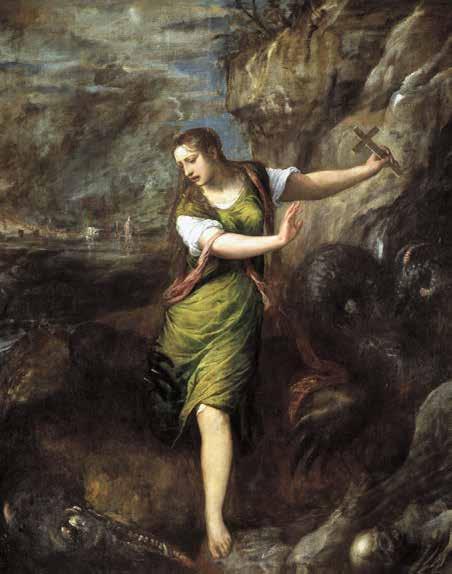





edited and introduced by
CARLO CORSATO athene pallas

Introduction by CARLO CORSATO
p. 7
Life of Titian, 1568
GIORGIO VASARI
p. 29
Supper and conversation in Titian’s house, 1540
FRANCESCO PRISCIANESE
p. 105
Letters about Titian, 1538, 1548 and 1550
PIETRO ARETINO
p. 113
Speaking of Titian, 1537
SPERONE SPERONI
p. 145
Titian, 1557
LUDOVICO DOLCE
p. 151
List of illustrations
p. 172

In the spring of 1566, Giorgio Vasari paid a brief visit to Venice, seeking new information for his publishing project. Two years later the second, expanded version of his Lives came out (1568), finally including an independent biography of Tiziano Vecellio da Cadore. More than a few eyebrows had been raised when in the first edition (1550) only passing mention had been made of the greatest living painter of the Serenissima Repubblica. Indeed for over twenty years Titian had formed part of the Parnassus of the finest artists of his time, which included Andrea Mantegna, Giovanni Bellini, Leonardo, Michelangelo, and even the two Dossi brothers. In the 1532 edition of Orlando furioso, the poet Ludovico Ariosto had gone so far as to say that just as Venice and Urbino could claim to be proud of Sebastiano del Piombo and Raphael, respectively, so the valley of Cadore at the foot of the Alps could pride itself on its most famous son. In the years to come, with his own art, the boy from the
Opposite: Venus Anadyomene, c. 1520
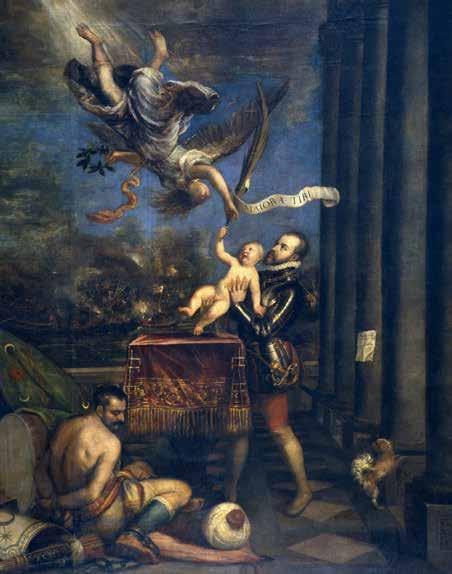

Dolomites would go on to conquer Venice, Italy and the courts of Europe, one after the other.
Ostensibly it seems inexplicable that the anti-Venetian prejudice of the 1550 edition of the Lives had also struck Titian, but in 1566, when he visited the artist’s house and workshop, Vasari was fully intending to make up for that error. The drafting of the biography was at this point at a very advanced stage, and his brief encounter with the aged master was put to use for the finishing touches. Compiling the material had been in progress since December 1563, when Cosimo Bartoli, a Florentine diplomat in Venice, had assured Vasari that he was already engaged on it: ‘As for the things on Titian, I shall also send you a note, which I have begun; but give me time’. Perhaps the painter himself was consulted, especially about paintings in Cadore and elsewhere beyond Venice, as well as commissions for Emperor Charles V, King Philip II of Spain, and other illustrious members of the Habsburg entourage. The same list was reused extensively by later authors believing (not entirely correctly) that it consisted mainly of first-hand information. In Il Riposo (1584), Raffaello Borghini summarized Vasari’s text and corrected only a misprint in Titian’s family name (‘Vccelli’ instead of the correct ‘Vecelli’).
Opposite: Philip II offering the Infante Fernando to Victory, 1573-75
In 1541-42, Vasari had already had occasion to make Titian’s proper acquaintance when he visited Venice for a few months, at the invitation of the man of letters Pietro Aretino (who came, as his name indicates, from Vasari’s own hometown of Arezzo). Aretino was one of the most influential socialites of his time, and his sharptongued invectives against those in power had earned him the epithet ‘scourge of princes’ ( flagello dei principi ). For the art of Titian, however (who was his close friend and frequent guest), Aretino was never sparing in his praise, above all in the sonnets, published in his Letters. In the Dialogue on Love (1542) by the Paduan humanist Sperone Speroni, the poet and courtesan Tullia d’Aragona had asserted that the poetry of the one was indissoluble from the portraits of the other: the sonnet lent voice to the canvas, and the painting clothed the verse in flesh and blood. In the Lives, however, Vasari transcribed only the opening of the sonnet on the Portrait of Francesco Maria della Rovere (Florence, Uffizi; see p. 11), attached to a letter of 1537 from Aretino to Veronica Gambara, but not even a short description was given of what he thought was ‘a marvellous work’.
Vasari was more fulsome about the paintings he had admired in Venice, including the three masterworks
Opposite: Pietro Aretino, c. 1537

 carlo corsato
carlo corsato
which had revolutionised the art of the altarpiece: the Assumption of the Virgin and the Pesaro Madonna in the Franciscan church of the Frari (both still in situ, see p. 15 and 161), and the Death of St Peter Martyr in the Dominican church of Santi Giovanni e Paolo (where it was destroyed by fire in 1867, see p. 114). He must then have been too busy to give them due attention, and he certainly failed to remember them clearly. A certain sloppiness, in fact, marked Vasari’s description of the Death of St Peter Martyr : he based it mainly on the engraving by Martino Rota (c. 1560) and neglected Aretino’s observations, included in his letter of 1537 to the sculptor Tribolo (see p. 115). As for the Assumption, Vasari stated that it was painted on canvas rather than wood panel, and lamented that it was poorly lit and badly looked after. After visiting Venice in 1582-83, the painter Annibale Carracci was so incensed by Vasari’s errors and misconceptions that he felt obliged to protest. A copy of the Lives (Bologna, Library of the Archiginnasio), among the annotations of six other unidentified authors, still preserves Carracci’s own remarks, some of them crude invective. In particular, commenting on the Assumption, Carracci explained that, although raking light might cast shadows over the picture during most of the day, there were particular times when its crisp colours could in fact be appreciated. It sounds as if Vasari did not bother to plan his visit properly.
If the details of the Lives need to be considered with care, its overall reconstruction of Titian’s career was nonetheless quite accurate, if excessively dramatized here and there. In Vasari’s account, for instance, after first appropriating the style of Giorgione, the young Titian then benefits from the death of Bellini (1516) to obtain his profitable sanseria (a lifelong broker’s license) with its annual emolument of 300 scudi and succeed him in the role of official painter of the Republic of Venice (1523). In reality, this license was worth less than half as much, and gave the painter no formal appointment; yet it sufficed for Titian to be accepted as the old master’s heir, obtain the job of portraying newly elected doges for the next thirty years, and complete Bellini’s grand canvas in the Doge’s Palace (lost in a fire in 1577).
Titian’s exceptionally new manner drew the attention of many patrons, both in Venice and beyond. In his General Principles of Architecture (1551 edition), Sebastiano Serlio set a list of famous names in stone:
if the great Titian, exemplar, father and master of painting in our time, had not first been highly rewarded – by Alfonso d’Este, Duke of Ferrara, who with great gifts knighted him; by the most generous Federico [Gonzaga] of Mantua, for whom he has made, and continues to make, many works; by
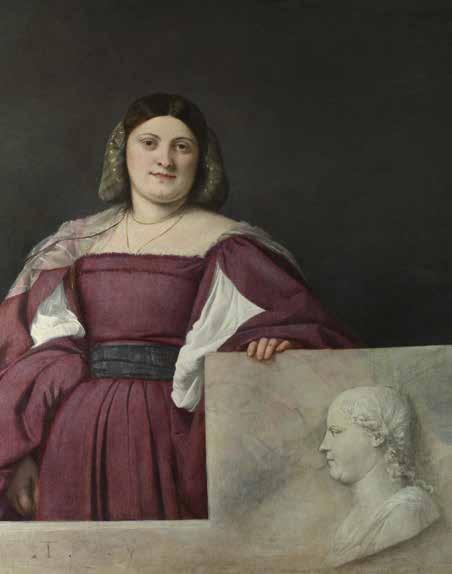

many other Lords and Cardinals, and above all Charles V, Emperor, portrayed by him, who has recognized his exalted virtue with great and honourable gifts and a new decoration of knighthood; and finally by Your Excellency [Alfonso d’Avalos, Marquis of Vasto], who has so kindly placed him under his protection – I cannot believe that he would ever have reached such heights in his works, as can be seen in him.
Serlio drafted the list before 1540, when Federico Gonzaga died, and it was followed by later biographers, who inserted all these prestigious patrons in their accounts on Titian and were more precise about some of the many commissions from eminent prelates. Vasari, for instance, mentioned the opening of Cardinal Giovanni della Casa’s sonnet on the portrait of the noblewoman Elisabetta Querini (lost). Only brief mention, however, was made by him of the The Allocution of the Marquis del Vasto to his Troops (Madrid, Prado; see p. 124) and, once again, Aretino’s description in a letter of 1540 to d’Avalos himself was ignored. It seemed Vasari wished to detract from the role of such an illustrious patron, under the ægis of whom Titian painted at least two other masterpieces: the Portrait of Alfonso d’Avalos (Los Angeles,
Opposite: Portrait of a woman (‘La Schiavona’), c. 1510-12
J. Paul Getty Museum, see p. 6) and the Crowning with Thorns for the church of Santa Maria delle Grazie in Milan (Paris, Louvre).
It was the courts of Ferrara and Mantua, however, that launched the painter onto the international stage. Alfonso d’Este, Duke of Ferrara, had asked Titian to modify the landscape in Bellini’s Feast of the Gods (Washington, DC, National Gallery of Art), so as to better attune the picture to the other mythologies created by him for the camerino d’alabastro (the Alabaster Study): the Worship of Venus, the Bacchanal of the Andrians (both Madrid, Prado), and Bacchus and Ariadne (London, National Gallery) – the last of these left unmentioned by Vasari. An even more crucial relationship was generated by the long-lasting patronage of Federico Gonzaga, Duke of Mantua and nephew of Alfonso d’Este: apart from creating a superb likeness of him (Madrid, Prado, see p. 64), Titian painted numerous religious and mythological subjects, as well as the cycle of the Eleven Cæsars (lost), which acquired a fame as legendary as that of the Triumphs of Cæsar by Andrea Mantegna commissioned by the Gonzaga over fifty years previously (Hampton Court, Royal Collections). Above all, it was with the help of Gonzaga that the painter entered the good graces of Charles V, who, as Giovan Paolo Lomazzo recalled in the Idea of the Temple
of Painting (1590), ‘loved and revered [Titian] as much as Alexander [the Great] had cherished Apelles’. Indeed, the Emperor sought to obtain the artist’s move to his court (1533-35), but in the end Ambassador Lope de Soria had to admit defeat:
I doubt he will go there [the Imperial Court], as I see him so much enamoured of and devoted to this, his Venice, which is starting to tire me, because it is certainly a kind prison for the likes of us little rascals.
Fifteen years later, though, Titian was persuaded to temporarily leave Venice, cross the Alps and meet Charles at the Diet of Augsburg (1548). Once again, Aretino did not fail to celebrate the visit of this Apelles to the court of his Alexander the Great. On that occasion Titian crafted another of his miracles, painting The Emperor Charles V at Mühlberg (Madrid, Prado; see p. 81), which over the next two centuries became the equestrian portrait par excellence for the rulers of Europe. We should not be surprised, then, that Prince Philip, the Emperor’s son, had set his eyes on Titian well before becoming King of Spain. This was not love at first sight, as he did not initially appreciate the painter’s swift and bold brushwork; in 1551, he confided to his aunt Mary
Overleaf: Bacchus and Ariadne, 1520-23
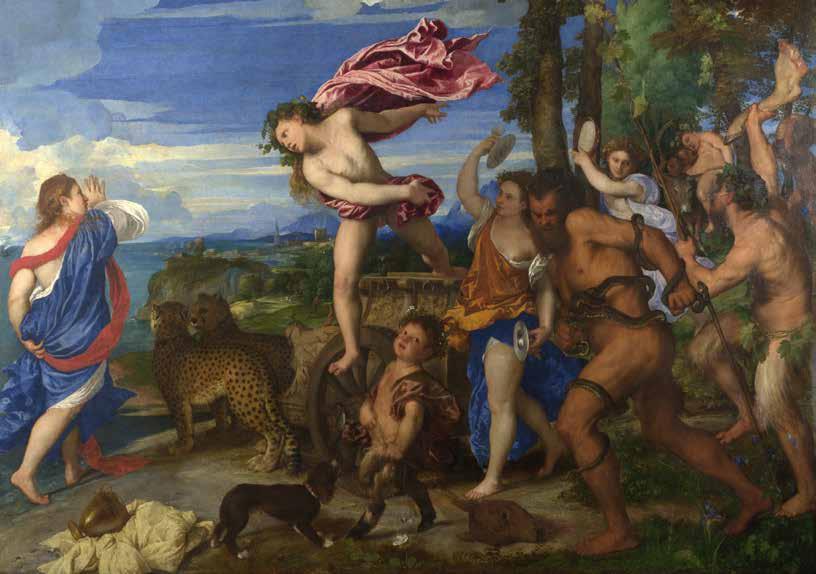
 carlo corsato
carlo corsato
of Hungary that ‘in my portrait in armour the haste with which he did it could clearly be perceived, and if there were more time I would make him re-do it’.
This did not stop Philip II from becoming Titian’s most generous and loyal protector in the subsequent twenty-five years. Yet the Habsburgs were not the only great men in his glorious career. In 1545-46, the painter spent about eight months in Rome as guest of Pope Paul III and the cardinal-nephew Alessandro Farnese. Vasari had enjoyed the same protection, and had the privilege of guiding Titian around the sites of classical antiquity and showed him the finest modern works and monuments. Shortly after his arrival, Cardinal Pietro Bembo, the great man of letters and friend and protector of Titian, had immediately written to the Venetian patrician Girolamo Querini:
Your (as well as our) Messer Titian is here, and he tells me that he is under great obligation to you for having been the cause of his coming to Rome, and passionately inciting him with the kindest words to make the trip [...]. He has already seen so many fine antiques that he is filled with wonder, and delighted that he came.
Vasari was somewhat less enthused when it came to noting Titian’s evolution, and maliciously quoted a
remark by Sebastiano del Piombo on the first state of the woodcut of the Triumph of Faith (1508):
if Titian had been in Rome at that time, and had seen the works of Michelangelo, those of Raphael, and the ancient statues, and had studied drawing, he would have done absolutely stupendous things, considering the beautiful mastery that he had in colouring.
After he had met the painter in Rome, while he was working on the Danaë for Cardinal Farnese (Naples, Museo Nazionale di Capodimonte), Michelangelo essentially confirmed the same judgment to Vasari: the art of colouring (colorito) was undoubtedly Titian’s strong point, but he would never have excelled in drawing and design (disegno). It is not surprising that Carracci annotated this passage with bitter disappointment. Not only did Michelangelo not appreciate Titian’s style, so different from his own, but above all it was offensive that Vasari had presented himself as the guide who had introduced Titian to the arts and antiques of Rome. If such impudence cost Vasari a scurrilous insult from Carracci, we may never know, on the other hand, whether Michelangelo really did express such a stern opinion. It is certain, however, that Vasari used the great artist’s authority to respond to a passage in the Dialogue on
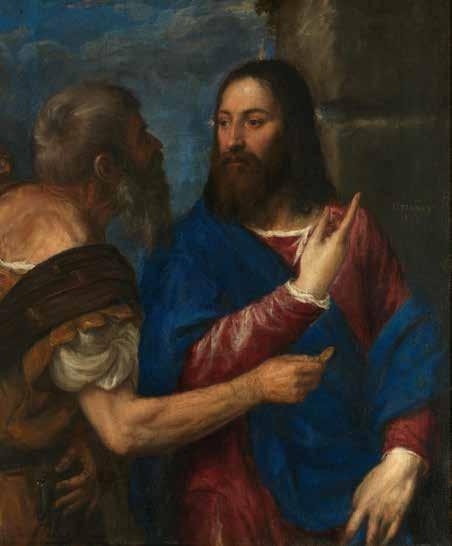

Painting, in which the Venetian theorist and friend of Titian, Ludovico Dolce, had entrusted to an imaginary Pietro Aretino – the real one had died in 1556, a year before its publication – the narration of the first biography of Titian ever written. According to Dolce/Aretino, the Assumption in the Frari, painted about thirty years before his journey to Rome, showed Titian’s ability to leave behind him the masters of the preceding generation (Gentile and Giovanni Bellini), and – inspired by the sole example of Giorgione – successfully combine ‘the grandeur and awe-inspiring quality’ of Michelangelo, ‘the pleasing grace and perfect beauty’ of Raphael, and ‘the proper colouring of Nature’. Hardly surprisingly, Vasari did not want to let Dolce get away with it.
However, if we read Dolce/Aretino carefully, Titian was not touched by these polemics: he disliked criticizing other artists, and in fact was a very modest man, notwithstanding the fact that even Apelles, the greatest painter of antiquity, would not have been averse to praising him. What is sure is that Aretino in his Letters, and then later Dolce in his Dialogue, gave ample shape to the overly sweet public image of Titian.
Named Count Palatine and Knight of the Golden Spur by the Emperor in 1533, Titian exuded the qualities
Opposite: The Tribute Money, 1560-68
of a refined gentleman with aristocratic manners: a person of fine speech, affable character and magnetic charisma. He respected religion but was not a conformist.
Corrado della Marca, a Conventual Franciscan friar who was confessor of both Titian and Aretino, had been arrested for encouraging ideas that were not entirely orthodox, so much so that painter and writer had used their influence to try to release him from the galleys in 1549.
Less turbulent but equally stimulating were the banquets held in the artist’s home, like the one in 1540 attended by the humanist Francesco Priscianese: the dinner guests in Titian’s garden that ferragosto evening included Aretino (a regular on such occasions), the writer Jacopo Nardi and the sculptor and architect Jacopo Sansovino.
A menu of delicacies and fine wines, a tour of the host’s works, and a discussion of Tuscan language over dessert all reminded Priscianese of those private gardens in Rome, the meeting-places of literati and cardinals.
An intellectual artist, Titian was not one to shrink from joining in the artistic debate of the age – the paragone, determining the primacy of sculpture or painting. Aretino asked Sansovino to make an effigy from the death mask of Giovanni delle Bande Nere, while Titian would have resurrected the late protector of the writer through one of his miraculous portraits. Not for nothing did Titian’s personal device, published in 1562
by Battista Pittoni, have as its motto Natura potentior ars – ‘Art [is] more powerful than Nature’. This was the equivalent of saying that a great and divine painter could exceed the limits of Nature. Little did it matter that in reality the portrait of Giovanni delle Bande Nere was executed by another painter, which enraged Aretino. What counted was that Titian was not an artisan of painting, but a poet of images. The implicit reference here was to the celebrated quotation from Horace: ut pictura poesis, or ‘as with painting so with poetry’. Titian’s late style spoke directly, and unaffectedly, with concealed brilliance, like the effortless nonchalance in manners and speech (sprezzatura) recommended by Baldassarre Castiglione in The Courtier. Vasari first realised one must look at Titian’s poetic paintings from a distance, as a close inspection would show no fine detail, just the energy and vibrancy of the master’s brushwork. Titian himself demonstrated this in his poesie, or visual poems, for Philip II, a mythological cycle inspired by Ovid’s Metamorphoses which included Venus and Adonis (Madrid, Prado), Diana and Callisto, Diana and Actæon (London, National Gallery, and National Galleries of Scotland), and The Rape of Europa (Boston, Isabella Stewart Gardner Museum).
A member of the jet set, like many another gentleman of his time this new Apelles enjoyed life’s pleasures and
Diana and Callisto, 1556-59
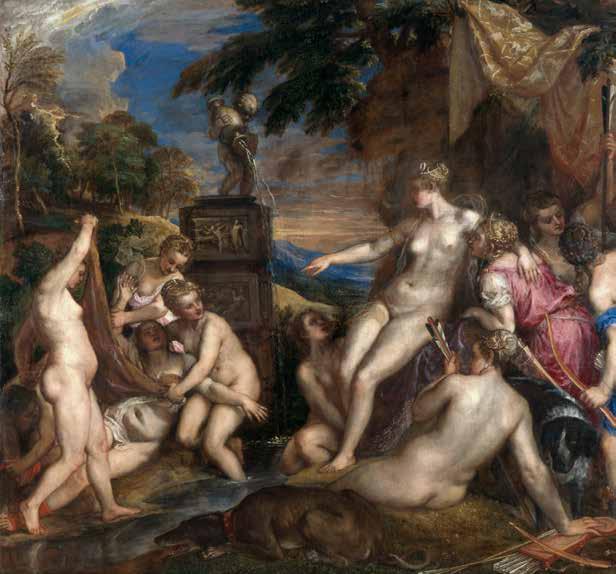
 carlo corsato
carlo corsato
shared his table with courtesans: in 1547, Aretino invited him to tuck into a brace of pheasants and enjoy the company of the celebrated Angela Zaffetta. In the same year, a certain Lucrezia (another lady of easy virtue) had attended the wedding of Orazio, Titian’s second son, who was also an artist. As in every family of stature, Titian’s was not without its black sheep: notwithstanding Aretino’s protection and the finest education, his first son Pomponio never found a true vocation, either in art or with the Church (the latter hoped for by his father), but by the irony of fate he remained the sole heir of the great artist. In 1576, the plague carried off Orazio, only weeks after the death of his father; but the memory of Titian survived in his works, together with the illusion that his art was really more powerful than Nature and Time.
 The Life of Tiziano Vecellio Painter
giorgio vasari
The Life of Tiziano Vecellio Painter
giorgio vasari